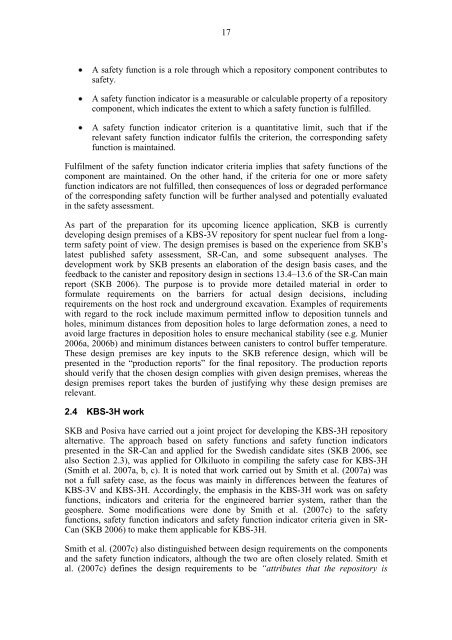RSC-Programme - Interim Report. Approach and Basis for - Posiva
RSC-Programme - Interim Report. Approach and Basis for - Posiva
RSC-Programme - Interim Report. Approach and Basis for - Posiva
You also want an ePaper? Increase the reach of your titles
YUMPU automatically turns print PDFs into web optimized ePapers that Google loves.
17A safety function is a role through which a repository component contributes tosafety.A safety function indicator is a measurable or calculable property of a repositorycomponent, which indicates the extent to which a safety function is fulfilled.A safety function indicator criterion is a quantitative limit, such that if therelevant safety function indicator fulfils the criterion, the corresponding safetyfunction is maintained.Fulfilment of the safety function indicator criteria implies that safety functions of thecomponent are maintained. On the other h<strong>and</strong>, if the criteria <strong>for</strong> one or more safetyfunction indicators are not fulfilled, then consequences of loss or degraded per<strong>for</strong>manceof the corresponding safety function will be further analysed <strong>and</strong> potentially evaluatedin the safety assessment.As part of the preparation <strong>for</strong> its upcoming licence application, SKB is currentlydeveloping design premises of a KBS-3V repository <strong>for</strong> spent nuclear fuel from a longtermsafety point of view. The design premises is based on the experience from SKB’slatest published safety assessment, SR-Can, <strong>and</strong> some subsequent analyses. Thedevelopment work by SKB presents an elaboration of the design basis cases, <strong>and</strong> thefeedback to the canister <strong>and</strong> repository design in sections 13.4–13.6 of the SR-Can mainreport (SKB 2006). The purpose is to provide more detailed material in order to<strong>for</strong>mulate requirements on the barriers <strong>for</strong> actual design decisions, includingrequirements on the host rock <strong>and</strong> underground excavation. Examples of requirementswith regard to the rock include maximum permitted inflow to deposition tunnels <strong>and</strong>holes, minimum distances from deposition holes to large de<strong>for</strong>mation zones, a need toavoid large fractures in deposition holes to ensure mechanical stability (see e.g. Munier2006a, 2006b) <strong>and</strong> minimum distances between canisters to control buffer temperature.These design premises are key inputs to the SKB reference design, which will bepresented in the “production reports” <strong>for</strong> the final repository. The production reportsshould verify that the chosen design complies with given design premises, whereas thedesign premises report takes the burden of justifying why these design premises arerelevant.2.4 KBS-3H workSKB <strong>and</strong> <strong>Posiva</strong> have carried out a joint project <strong>for</strong> developing the KBS-3H repositoryalternative. The approach based on safety functions <strong>and</strong> safety function indicatorspresented in the SR-Can <strong>and</strong> applied <strong>for</strong> the Swedish c<strong>and</strong>idate sites (SKB 2006, seealso Section 2.3), was applied <strong>for</strong> Olkiluoto in compiling the safety case <strong>for</strong> KBS-3H(Smith et al. 2007a, b, c). It is noted that work carried out by Smith et al. (2007a) wasnot a full safety case, as the focus was mainly in differences between the features ofKBS-3V <strong>and</strong> KBS-3H. Accordingly, the emphasis in the KBS-3H work was on safetyfunctions, indicators <strong>and</strong> criteria <strong>for</strong> the engineered barrier system, rather than thegeosphere. Some modifications were done by Smith et al. (2007c) to the safetyfunctions, safety function indicators <strong>and</strong> safety function indicator criteria given in SR-Can (SKB 2006) to make them applicable <strong>for</strong> KBS-3H.Smith et al. (2007c) also distinguished between design requirements on the components<strong>and</strong> the safety function indicators, although the two are often closely related. Smith etal. (2007c) defines the design requirements to be “attributes that the repository is
















